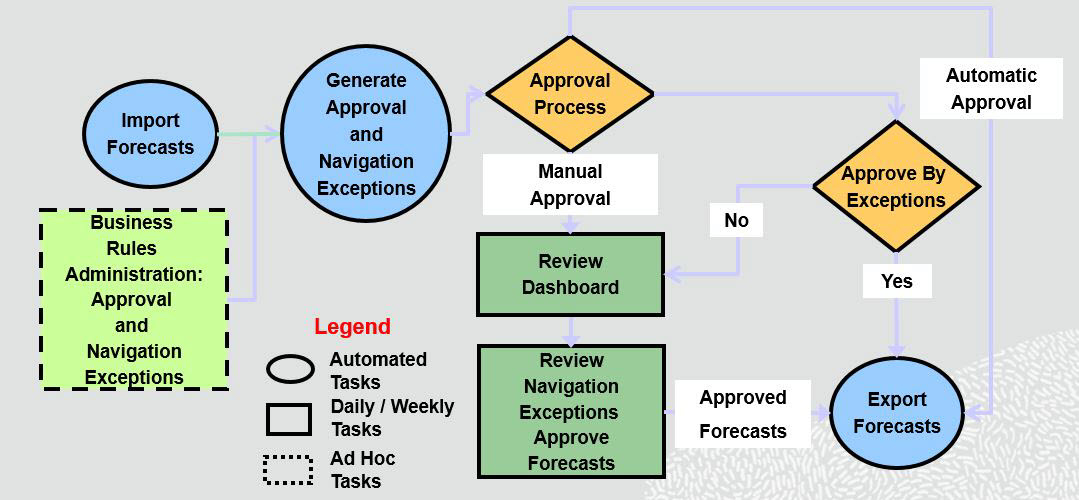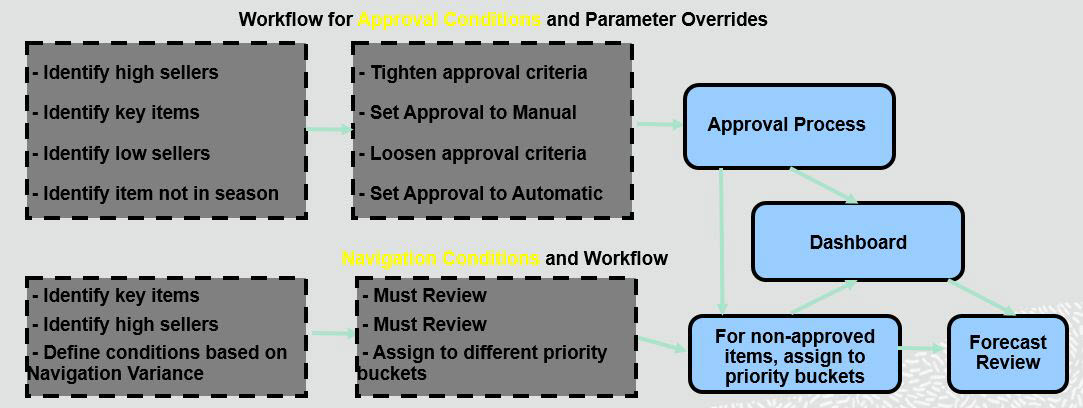C Appendix: Business Rule Engine
Oracle Retail has designed the Business Rule Engine (BRE) to help IPOCS-Demand Forecasting users set up business strategies to manage parameters used in the forecast approval and navigation processes. Parameters include alert thresholds, alert calculation window, as well as navigation criteria. These parameters can be set up manually in the forecast setup workbook at the global, intermediate, and final levels (override). With the business rule engine, the parameter values at final level can be dynamically adjusted based on business requirements. No patching of the environment is required. For example, a business strategy can be to set the alert error threshold to 10% for all product/locations combos with average sales larger than 10 units per week. For product/locations with average sales less than 10 units per week, the threshold can be relaxed to 20%. This way high sellers have a tighter error threshold because they are more important for the business, and the analysts may want to review their forecasts more rigorously. Using this approach, the parameter values were assigned to product/locations based on business strategy rather than hierarchy positions.
The BRE is used in br-engine.fm mainly in the approval process. This has been refined to include multiple stages. At a high level these are:
-
Automatically adjust the system forecast
-
Run the approval exceptions
-
Assign the unapproved product/locations to navigation buckets based on business priorities you have set up
-
Finally, in the Forecast Review workspace, review/adjust/approve product/locations being guided by the navigation exceptions.
Figure C-1 depicts the overall approval process
Figure C-1 Approval Workflow

Notice how the work done in the BRE is mentioned as an infrequent task. You only need to access it when you want to change business rules regarding approval and/or navigation strategies.
The interaction with the BRE is depicted in Figure C-2.
Figure C-2 Business Rule Engine

You start with the rules conditions, then adjust the approval exceptions requirement, and finally the navigation strategies.
Examples of how approval rule conditions can be used:
-
High margin items: tighten approval criteria
-
Key items: never approve, too important
-
Product/locations not in season: approve automatically
-
Low sellers: Loosen approval criteria
After the approval exception process is run, there will be a pool of product/locations that are approved and a pool of product/locations that are not approved. However, not all product/locations in this pool have the same criticality.
This is where the navigation exceptions come in the picture. The unapproved product/locations are run through the business rules for navigations and assigned to different navigation buckets. Let say we have four buckets for navigation: Urgent, Required, Optional, and Informational. You can set conditions to achieve the following assignments on unapproved product/locations to navigation buckets (or tiers).
-
Urgent- key items, high sellers
-
Required- decent sellers and high navigation variance
-
Optional- high navigation variance
-
Informational- all other unapproved items
Note:
The navigation variance is calculated during the approval exception process and it records by how much the forecast was off from the measure it was compared to.
Figure C-3 illustrates the concepts of approval and navigation conditions, as well as how they support the approval workflow for the previous example.
Figure C-3 Rule Conditions

Figure C-4 and Figure C-5 show images of the Rule Condition Setup views in the UI for approval and navigation.
Figure C-4 Approval Conditions
Figure C-5 Navigation Conditions